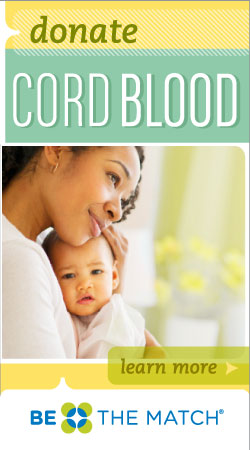You are here
Celebrating the Anniversary of the 1st Cord Blood Transplant
 October is the anniversary of the first umbilical cord blood transplant and it marks an important opportunity to increase understanding among expectant parents and the public about cord blood options.
October is the anniversary of the first umbilical cord blood transplant and it marks an important opportunity to increase understanding among expectant parents and the public about cord blood options.
For many years, Parent's Guide to Cord Blood Foundation has worked closely with the National Marrow Donor Program® (NMDP/Be The Match®), a nonprofit organization that manages the largest and most diverse registry of potential adult marrow donors and publicly donated cord blood units in the world. The collaboration exists to raise awareness of cord blood options in the hopes of encouraging more expectant parents to take advantage of the potential of this incredible source of blood stem cells.
NMDP/Be The Match® is the U.S. hub of a global transplant network that connects more than 600 leading transplant centers worldwide. All centers in the network must meet the quality standards of NMDP/Be The Match®. These standards are put in place to make sure that donors and patients receive high quality care and that government standards are met.
In 2005, the NMDP/Be The Match® was selected by the U.S. government to serve as the nation's Cord Blood Coordinating Center. NMDP/Be The Match® works with public cord blood banks, physicians and researchers to continually improve cord blood transplantation and educate medical professionals and the public.
The need for increased awareness among the public is great. Every year, countless mothers experience the miracle of life when they bring their newborns into the world. However, many are not aware that they can provide a miracle for others as well.
The Process
It is important for expectant mothers to know that there is no cost to donate to a public cord bank, and donation is safe for the mother and the baby. Cord blood is collected from the umbilical cord immediately after birth and does not affect the labor or delivery in any way. Following the donation, the cord blood is tested, frozen and stored as a cord blood unit at a public cord blood bank for future use.
Donated cord blood that meets the requirements can be listed on the Be The Match® Registry and made available to any searching patient who needs a blood stem cell transplant.
Needs and Challenges
As many in the medical community are aware, publicly donated cord blood can now be a potentially life-saving treatment option for patients battling one of more than 70 different diseases, including blood cancers, sickle cell disease and many other life-threatening illnesses.
But despite its potential, most cord blood is discarded, because of lack of awareness about the option to donate cord blood. More donations are needed, so that more patients can get the transplant they need.
The most urgent need among public cord blood banks is donated cord blood from babies whose parents are of diverse ethnic and racial backgrounds. Patients are more likely to find a match with cord blood units from someone who shares their ethnicity. Overall, there are fewer numbers of cord blood units from diverse populations on the Be The Match® Registry, making it more difficult for minority patients to find a match.
Quality collection is critical. A large percent of publicly donated cord blood units are not able to be stored for transplantation. Cord blood units collected for public donation follow strict quality standards to provide the best possible result for transplant patients. It is important that the cord blood unit contains enough blood-forming cells for a successful transplant. If there are too few cells, the cord blood unit cannot be listed on the registry.
While organizations like the NMDP/Be The Match® and Parent's Guide to Cord Blood Foundation are raising awareness about the need for donated cord blood units, donation is not available in every state due to the high costs of opening a cord blood bank and collecting and storing cord blood units. To ensure that patients have an acceptably matched cord blood unit on the registry, additional financial resources are needed to increase opportunities for donation, collection and storage of cord blood units.
Progress
Despite the challenges, more than 622,000 units are now available worldwide through the Be The Match® Registry and our international network partners, and most patients (81-99%, depending on race or ethnicity) are able to find a matching cord blood unit on the Be The Match® Registry. This is great progress, but there is more to be done, because we are still not able to provide a matching cord blood unit for every patient in need of a transplant.
For more information about the NMDP/Be The Match® and cord blood donation, visit BeTheMatch.org/cord.


